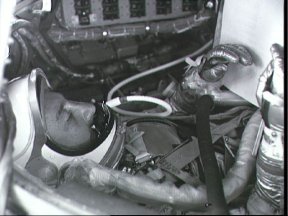Click on image for full size
Courtesy of NASA
Related links:
It's Time to Clean the Liberty Bell!
News story originally written on 11/11/99
Scientists are currently cleaning one of the oldest and most fascinating spacecraft ever known. The Liberty Bell 7, flown by Astronaut Gus Grissom in 1961, was trapped on the bottom of the Atlantic Ocean until this past summer. It was then that expert salvager Curt Newport succeeded in bringing the spacecraft up 15,000 feet to the surface. But the recovery was only the beginning. Now the Liberty Bell 7 is housed at the Cosmosphere in Kansas, where it will be cleaned and rebuilt for future generations.
"On the night (of the recovery), you could almost hear the angels in the background when that spacecraft came up out of the water," said Max Ary, president and CEO of the Cosmosphere. "That was one of the eeriest, most strange sensations I had in my life."
Surprisingly, after all these years, much of the spacecraft's contents remains intact. Papers, money, even a pencil, remained. Unfortunately, some of the metal making up the spacecraft has turned to dust. What remains is being cleaned, all 25,000 pieces! Scientists are using drills, grinders and even dental equipment to clean every part of the spacecraft, even the nuts and bolts. Every part was covered in grime and dirt that had built up for over 30 years. The restoration project is expected to take 6 months. However, anyone who visits the Cosmophere can watch as scientists restore the capsule.
"If we don’t bring these things back and allow people to view them and learn the history, the American people will surely, slowly forget just what it took to make us such a great nation," said Greg Buckingham, one of the scientists working on the project.
The items found inside the Liberty Bell are even more interesting than the capsule itself. A checklist and pencil used by Grissom just before the ship sank was hidden safely inside a pouch. Old mercury dimes, which were supposed to be given to friends of the astronaut, were spread across the floor. Even the cap to the hatch which blew off the capsule and caused it to sink was found. Together, the pieces remaining will represent a glimpse of an age long gone.
"If you show a spacecraft as a spacecraft, there’s a certain element of people who
will find it of interest and other people who couldn’t care the least," Ary said. "But if
you can tell a life and death story it doesn’t matter where your interest is, you can
relate to life and death. That becomes the universal thread."















